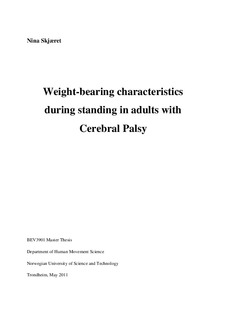| dc.description.abstract | Aim: The aim of this study was to investigate weight-bearing characteristics in young adults with CP compared to young healthy adults in both quiet and relaxed standing.
Methods: Two standing conditions were tested, one minute quiet standing (QS) and one minute relaxed standing (RS) in both groups. Data were collected with two Kistler force plates and a video camera. Weight-bearing asymmetries, shifts in weight bearing and CoP movements under each foot were calculated in Matlab, and PSAW Statistics was used for statistical analysis.
Results: There were large individual differences in weight bearing characteristics between feet in both CP participants and control participants. In the QS condition, the CP group had equal weight on both feet in average across the trial, a trend towards a higher asymmetrical weight bearing index (p=.08), and larger movements of CoP under each foot than the control participants. In the RS condition, the CP group had no difference in weight bearing between the feet, more shifts in weight bearing in the form of steps, and less asymmetrical weight bearing index than the control group. Also, the CP participants had more CoP movements on their non-affected side than the controls had on their dominant side, and less CoP movements on their affected side than the controls had on their non-dominant side.
Conclusion: CP participants have several different strategies for maintaining upright standing posture, varying from largely relying on their non-affected side for weight support, to standing almost symmetrical, to supporting more weight on their affected leg. Even though CP participants have more asymmetrical weight bearing in quiet standing compared to controls, this is not the case in relaxed standing where controls are more asymmetrical. This study provides more insight into relaxed standing and the strategies CP patients use to maintain an upright standing posture. Future studies should investigate the prevalence of postural asymmetry in a larger sample of patients, for a longer period of time, and how possible findings can be used in treatment of this patient group.
Key words: Cerebral palsy, quiet standing, relaxed standing, weight-bearing asymmetries, shifts in weight-bearing, center of pressure. | nb_NO |
